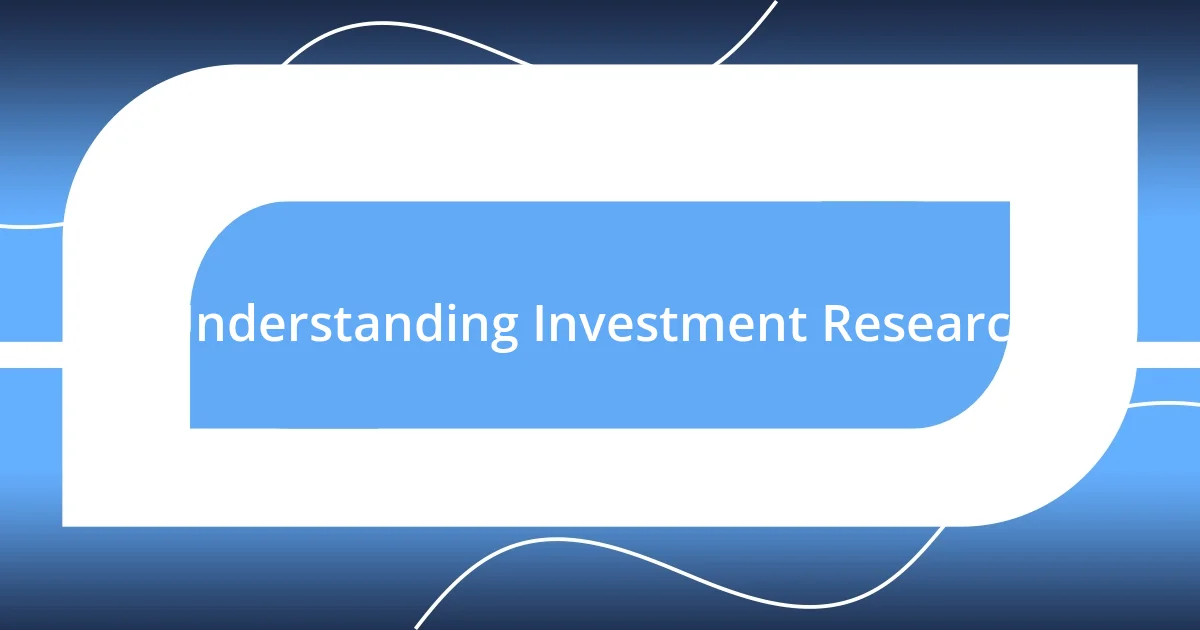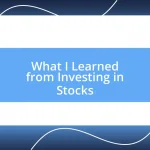Key takeaways:
- Investment research combines both quantitative and qualitative factors; understanding the narrative behind investments is vital.
- Setting clear investment goals, timelines, and aligning them with personal values can enhance decision-making and emotional resilience.
- Assessing risk tolerance and seeking reliable information sources are essential to making informed, strategic investment choices.

Understanding Investment Research
Investment research isn’t just a set of dry statistics; it’s a journey into understanding the potential of a financial decision. I often think of it as piecing together a puzzle. Each piece—be it market trends, company performance, or economic indicators—will help to create a clearer picture of what might lie ahead.
When I first started investing, I often felt overwhelmed by the plethora of information available. I remember sifting through endless articles, trying to find the truth amidst the noise. It dawned on me that the real skill in research isn’t just gathering facts; it’s about discerning what’s relevant and how it relates to my investment goals. Have you ever found yourself lost in data, questioning which numbers truly matter? It’s a common hurdle that, once navigated, can lead to more informed and confident decisions.
Moreover, I’ve learned that qualitative factors are just as crucial as quantitative ones. I recall investing in a startup after deep diving into its leadership team’s vision and passion, not solely the financial metrics. Their enthusiasm resonated with me and made me believe in their potential. Don’t underestimate the power of narrative in your research—sometimes, the stories behind the investments can illuminate the path to success or uncover hidden risks.

Setting Clear Investment Goals
Setting clear investment goals is paramount in my investment journey. When I first began, my goals were vague and unfocused, leading to impulsive decisions. I quickly realized that clear, specific goals—like saving for retirement or funding a child’s education—helped me choose the right investment strategies and assets. Have you ever felt the clarity that comes from knowing exactly what you want? It transforms your research process into a targeted venture rather than a scattershot approach.
My experience has shown that setting a timeline for each goal can provide even more direction. For instance, when I set a five-year horizon to buy my first home, I carefully curated my investment choices based on that objective. Each decision was driven by my target date, ensuring that my portfolio aligned with my vision. Establishing this time frame, for me, was a game-changer. It reinforced my commitment to my goals and made me more aware of my risk tolerance during the research phase.
One thing that stands out from my journey is the emotional aspect of setting goals. I recall feeling incredibly motivated when I aligned my investments with a cause I care about—sustainable energy. Knowing my money was contributing to a better world made my research feel purposeful and enriching. That emotional connection not only guided my selections but also bolstered my resilience during market fluctuations. How often do you consider your emotional motivations when setting your investment goals? It’s an essential layer that can enhance your overall experience.
| Type of Goal | Description |
|---|---|
| Short-term | Goals within 1-3 years, like vacation funds or emergency savings |
| Medium-term | Goals spanning 3-7 years, such as buying a home or funding education |
| Long-term | Goals over 7+ years, including retirement planning and wealth accumulation |

Identifying Reliable Information Sources
Identifying reliable information sources is crucial in making informed investment decisions. Throughout my own investing journey, I’ve learned to be discerning about where I source my information. I’ve often relied on a mix of established financial news outlets, expert analyses, and even seasoned investors’ insights. For instance, I remember when I followed a specific market guru, whose analysis not only educated me but also provided a sense of community through shared insights.
When seeking reliable sources, consider the following:
- Reputable Financial News Outlets: Look for well-established publications like Bloomberg, The Wall Street Journal, or The Financial Times.
- Official Reports and Filings: Company earnings reports, SEC filings, and annual reports are goldmines for accurate data.
- Investment Blogs and Forums: Engage with thoughtful discussions on platforms like Seeking Alpha or investment subreddits, but verify the credibility of contributors.
- Academic Research and Journals: Don’t overlook research papers and studies; they often provide a deeper context beyond headlines.
- Word of Mouth from Trusted Investors: My own network of friends who are investors has been invaluable; their real-life experiences often shed light on aspects I wouldn’t find in articles.
The truth is, filtering through vast amounts of information can feel like searching for a needle in a haystack. I still vividly recall a time when I stumbled upon a well-researched article about a tech startup from a lesser-known platform, which turned out to be a solid investment. That experience taught me the importance of keeping an open mind about where I gather my insights. Trust your instincts but remain vigilant—information can be misleading, and a single unreliable source can throw off your entire research process.

Analyzing Market Trends and Data
When I dive into market trends, I always start by examining the historical performance data of the asset class I’m interested in. Analyzing charts and graphs helps me spot patterns that can signal potential future movements. Have you ever taken a moment to look back at how a stock reacted to past economic events? It’s fascinating how history can sometimes repeat itself if we pay close enough attention.
Examining broader economic indicators—like unemployment rates, interest rates, and consumer confidence—can provide valuable context too. I remember a time when I overlooked rising inflation figures while focusing solely on stock performance. The result was a harsh wake-up call when markets adjusted. Now, I make it a point to keep an eye on these indicators, as they often provide clues about market sentiment and the overall economic landscape.
Sometimes, I find myself questioning whether the trends I’m observing align with my investment thesis. Engaging with tools like moving averages or momentum indicators can clarify these doubts. For instance, I recently utilized a moving average crossover strategy that confirmed my instincts about an emerging market trend. Trusting data is one aspect, but trusting my intuition—reinforced by data—has become a key part of my research process. Have you ever wrestled with that balance between analysis and gut feeling? It’s a tricky but rewarding journey.

Evaluating Company Financials
When evaluating company financials, I often start with the income statement, which provides a clear picture of profitability. I remember feeling a sense of reassurance when I first analyzed a company’s revenue growth in conjunction with their net income. It struck me how a consistent upward trend could indicate strong management and healthy market demand. Have you ever noticed how earnings can be a relief or a red flag, depending on their trajectory?
Next, I dive into the balance sheet, focusing on the company’s assets, liabilities, and equity. This gives me insight into the company’s financial stability and how well it can manage its debts. There was a moment when I passed on an investment in a well-known retail brand because their debt-to-equity ratio was alarmingly high. That lesson taught me that even popular companies can carry significant risks, hidden from the casual observer. Are you paying enough attention to these crucial indicators?
Finally, I can’t overlook cash flow statements. They often reveal the company’s liquidity and its ability to sustain operations. I distinctly recall a tech firm I invested in that had impressive profits but lacked solid cash flow. A few months later, they faced a precarious situation that made me question my decision. Remember, profits on paper mean little without real cash to back them up. Understanding this taught me to dig deeper, ensuring that I’m not just dazzled by surface-level numbers but really grasping the financial health of a company. How do you balance the allure of growth stories with the necessity of robust financials?

Assessing Risk Tolerance and Impact
Assessing risk tolerance is one of the first steps I take before making any investment decisions. I often reflect on my past experiences, recalling an instance when I invested heavily in a startup without fully understanding my own discomfort with volatility. The surge of excitement quickly turned into anxiety as the company struggled, reminding me that it’s crucial to match investments with my personal comfort level. Have you ever jumped into an investment only to realize it was more than you bargained for?
As I delve deeper into understanding impact, I examine how my potential investments align with my values and long-term goals. I vividly remember recommending a green technology firm to a friend, thinking it was a safe bet because of its environmental mission. However, when I saw the risk associated with its funding models, I second-guessed my instincts. This taught me that aligning investments with personal ethics can amplify the emotional stakes, impacting my overall risk assessment. Do you ever weigh the significance of purpose against potential returns in your investment choices?
I also consider scenario planning, imagining various outcomes and impacts based on different market conditions. One time, I crafted multiple scenarios for a renewable energy investment—optimistic, realistic, and pessimistic. Each one shook me in different ways, prompting reconsideration on whether I could truly handle potential losses. This exercise honors both my comfort with risk and the real-world volatility of investments. How do you prepare for the unpredictable nature of the market? Trusting my instincts through this process has become invaluable for my investment journey.

Making Informed Investment Decisions
Making informed investment decisions is a multifaceted process that goes beyond analyzing numbers on a page. I recall a specific moment when I almost greenlit an investment in a trendy tech startup simply because everyone else was doing it. As I stepped back and asked myself, “What’s my real understanding of their business model?” I realized I didn’t grasp how they planned to sustain growth long-term. This pause allowed me to dig deeper, prompting me to discover they were operating at a significant loss, which made me reconsider my initial enthusiasm. Have you ever felt the rush of wanting to invest just because it seemed like the thing to do?
I also find it vital to keep an open line of communication with others who have experience in the field. One of my most enlightening discussions happened over coffee with a seasoned investor who encouraged me to look beyond surface-level trends. They asked me, “What’s the company culture like?” It seemed like such a simple question, yet it led to a profound realization about how internal dynamics can impact performance. Understanding that a strong, positive culture often correlates with better financial results was a game-changer for me. How often do you consider the underlying factors that contribute to a company’s success?
Lastly, I don’t underestimate the power of continuous education. I enjoy diving into books, podcasts, and webinars that explore diverse investment strategies. During one of these sessions, a simple quote hit home: “Price is what you pay; value is what you get.” This shifted my perspective, prompting me to focus more on a company’s true worth rather than just its market price. It’s a reminder that due diligence isn’t just about gathering data—it’s about truly understanding what you’re investing in. Implementing these lessons has made my investment journey not just about numbers, but about informed, strategic choices. What kind of resources do you lean on for your investment knowledge?














